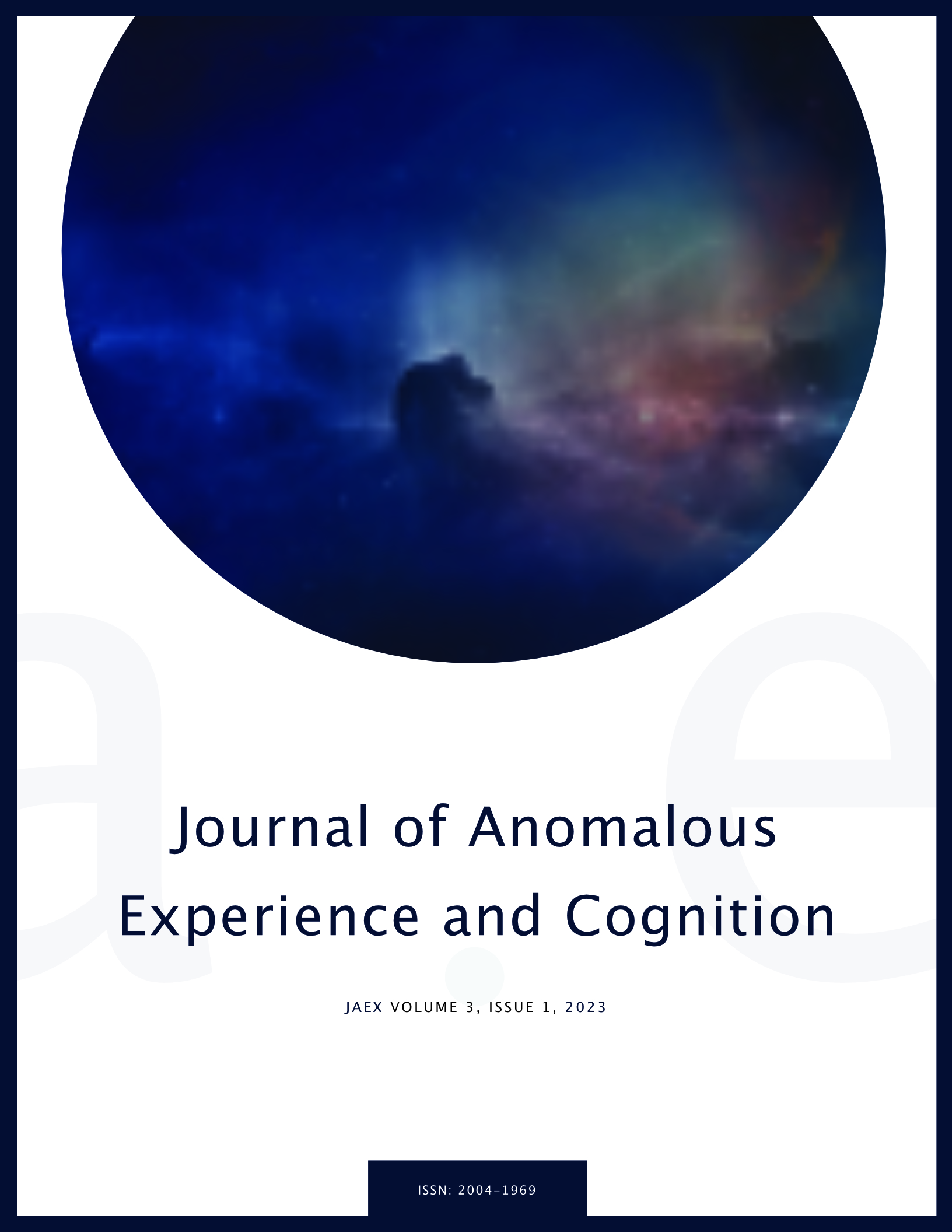The Definitive Account of Early Mediumship
A Review of The Heyday of Mental Mediumship: 1880s-1930s: Investigators, Mediums and Communicators
DOI:
https://doi.org/10.31156/jaex.24984Keywords:
mediumship, channeling, psychical research, history of psychical research, parapsychology, survival, society for psychical research, anomalous cognition, Society for Psychical ResearchAbstract
Following his acclaimed earlier study on mediumship and survival, Alan Gauld provides a more complete account of about 50 years of early studies on mediumship with a select group of mediums (e.g., Mrs. Piper, Mrs. Leonard, Mrs. Dowden). He describes in detail why many if not most of the criticisms against extraordinarily accurate accounts by these mediums do not hold water when analyzed in detail. Gauld does not provide easy answers, but in his masterwork does something much more important by offering a justification to those who may want to base their belief of potential survival on empirically defensible grounds.
References
Acree, M. C. (2021). The myth of statistical inference. Springer.
Bakan, D. (1969). On method. San Francisco: Jossey-Bass.
Beischel, J., & Zingrone, N. (2015). Mental mediumship. In E. Cardeña, J. Palmer, and D. Marcusson-Clavertz (Eds.), Parapsychology: A handbook for the 21st century (pp. 301–313). McFarland.
Beischel, J., & Schwartz, G. E. (2007). Anomalous information reception by research mediums demonstrated using a novel triple-blind protocol. Explore, 3, 23-27.
Bergman, L. R., & Lundh, L.-G. (2015). Introduction: The person oriented approach: Roots and Roads to the future. Journal for Person Oriented Approach, 1(1-2). https://doi.org/10.17505/jpor.2015.01
Cardeña, E. (2014). A call for an open, informed, study of all aspects of consciousness. Frontiers in Human Neuroscience, doi: 10.3389/fnhum.2014.00017.
Cardeña, E. (2015). Eminent people interested in psi. https://psi-encyclopedia.spr.ac.uk/articles/eminent-people-interested-psi.
Cardeña, E. (2019). “The data are irrelevant”: Response to Reber and Alcock. Journal of Scientific Exploration, 33(4), 593-598.
Cardeña, E., Palmer, J., & Marcusson-Clavertz, D. (2015). Parapsychology: A handbook for the 21st century. McFarland.
Cardeña, E., Schaffler, Y., & Van Duijl, M. (2023). The other in the self: Possession, trance, and related phenomena. In M. J. Dorahy, S. N. Gold, & J. A. O’Neill (Eds.), Dissociation and the dissociative disorders: Past, present, future. 2nd ed. (pp. 421-432). Routledge. doi: 10.4324/9781003057314-31
Fischer, A., & Knoefel, T. (Eds.) (2007). Okkulte stimmen – mediale music: Recording of unseen intelligence (3 cds) Supposé.
Gauld, A. (1982). Mediumship and survival. Heinemann.
Gauld, A. (1968). The founders of psychical research. Routledge & Kegan Paul.
Gurney, E., Myers, F. W. H., Podmore, F., Sidgwick, H., Stack, J. H., Sidgwick, H., Mrs., & Hodgson, R. (1885). Report of the committee appointed to investigate phenomena connected with the Theosophical Society. Proceedings of the Society for Psychical Research, 3, 201–400.
Hövelmann, G. H. (2015). On the usefulness of parapsychology for science at large. In E.
Cardeña, J. Palmer, & D. Marcusson-Clavertz (Eds.), Parapsychology: A handbook for
the 21st century (pp. 389-398). McFarland.
Hövelmann, G. H. (2015). On the usefulness of parapsychology for science at large. In E.
Cardeña, J. Palmer, & D. Marcusson-Clavertz (Eds.), Parapsychology: A handbook for
the 21st century (pp. 389-398). McFarland.
Hövelmann, G. H. (2015). On the usefulness of parapsychology for science at large. In E.
Cardeña, J. Palmer, & D. Marcusson-Clavertz (Eds.), Parapsychology: A handbook for
the 21st century (pp. 389-398). McFarland.
Hövelmann, G. H. (2015). On the usefulness of parapsychology for science at large. In E.
Cardeña, J. Palmer, & D. Marcusson-Clavertz (Eds.), Parapsychology: A handbook for
the 21st century (pp. 389-398). McFarland.
mann, G. H. (2015). On the usefulness of parapsychology for science at l
Hövelmann, G. H. (2015). On the usefulness of parapsychology for science at large. In E. Cardeña, J. Palmer, & D. Marcusson-Clavertz (Eds.), Parapsychology: A handbook for the 21st century (pp. 389-398). McFarland.
Jarrell, R. (1953). Reflections on Wallace Stevens. In Poetry and the age. Faber and Faber.
Keller, E. F. (1983). A feeling for the organism: The life and work of Barbara McClintock. Freeman.
Monteiro de Barros, M., Camelo Leão, F., Vallada Filho, H., Lucchetti, G., Moreira-Almeida, A., & Prieto Peres, M. F. (2022). Prevalence of spiritual and religious experiences in the general population: A Brazilian nationwide study. Transcultural Psychiatry. https://doi.org/10.1177/13634615221088701
Sarraf, M., Woodley Of Menie, M. A., & Tressoldi, P. (2021). Anomalous information reception by mediums: A meta-analysis of the scientific evidence. Explore, 17(5), 396–402. https://doi.org/10.1016/j.explore.2020.04.002
Sidgwick, M. H. (1915). A contribution to the study of the psychology of Mrs. Piper’s trance phenomena. Proceedings of the Society for Psychical Research, 28, 1–657.
Sidgwick, M. H. (1922). Phantasms of the Living: An Examination and Analysis of Cases of Telepathy between Living Persons Printed in the "Journal" of the Society for Psychical Research since the Publication of the Book "Phantasms of the Living," by Gurney, Myers and Podmore in 1886. Proceedings of the Society for Psychical Research 33, 23-429.
Thomas, J. F. (1937). Beyond normal cognition. Boston Society for Psychic Research.
Williams, B. J. (2019). Reassessing the “impossible”: A critical commentary on Reber and Alcock’s “Why Parapsychological claims cannot be true.” Journal of Scientific Exploration, 33(4), 593-616.
Downloads
Published
How to Cite
Issue
Section
License
Copyright (c) 2023 Etzel Cardeña

This work is licensed under a Creative Commons Attribution 4.0 International License.
All articles published in JAEX are open access, freely and universally accessible online, and archived in the open journal’s Lund University website (https://journals.lub.lu.se). Articles in JAEX can be distributed under the terms of the Creative Commons Attribution 4.0 International License CCBY (http://creativecommons.org/licenses/by/4.0/), which permits unrestricted use, distribution, and reproduction in any medium, with appropriate credit to the original author(s) and the source, a link to the Creative Commons license, and an indication if changes were made.



